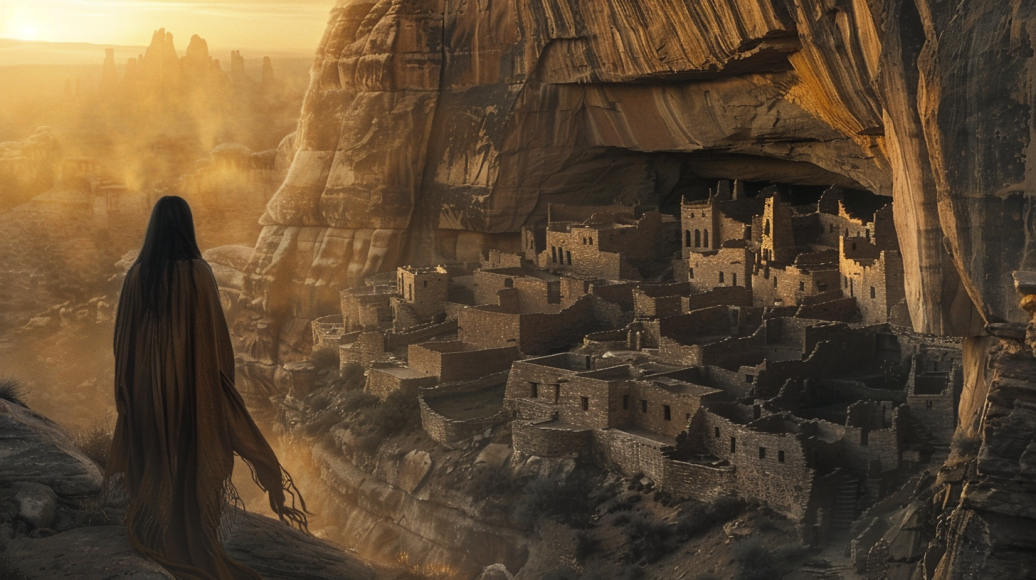Introduction
The Ancestral Puebloans, also known as the Anasazi, built impressive cliff dwellings in the American Southwest. Around the late 13th century, they suddenly abandoned these settlements. The reasons for their disappearance—whether due to drought, warfare, or other factors—remain unclear. This article explores the history, culture, and possible reasons behind the mysterious disappearance of the Ancestral Puebloans.
Historical Background
The Ancestral Puebloans began to rise around 100 AD, flourishing in the Four Corners region where modern-day Arizona, New Mexico, Colorado, and Utah meet. They are known for their unique cultural and architectural achievements, particularly their cliff dwellings.
Architectural Marvels
The Ancestral Puebloans are famed for their cliff dwellings, carved into the sides of mesas and canyon walls. Notable sites include Mesa Verde, Chaco Canyon, and Bandelier. These structures, built from sandstone and wooden beams, showcase their advanced architectural skills and ability to adapt to their environment.
Daily Life and Society
The Ancestral Puebloan society was complex and well-organized. They lived in large, communal structures and relied on agriculture, particularly maize cultivation. They also engaged in extensive trade networks, exchanging goods such as pottery, turquoise, and food with neighboring cultures.
Religious and Cultural Practices
Religion and spirituality played a significant role in Ancestral Puebloan life. They conducted rituals and ceremonies in kivas—underground chambers used for religious purposes. Artistic expressions, including pottery and rock art, depict their beliefs and daily life.
Technological and Agricultural Innovations
The Ancestral Puebloans developed sophisticated irrigation techniques to farm in the arid Southwest. They built dams, terraces, and reservoirs to manage water and sustain their agriculture. Their architectural innovations, such as multi-story buildings and kivas, reflect their advanced knowledge and skills.
Theories of Disappearance
Climate Change and Drought Hypotheses
One prominent theory suggests that prolonged droughts led to crop failures and water shortages, forcing the Ancestral Puebloans to abandon their settlements. Tree-ring data indicates significant periods of drought during their time.
Warfare and Conflict Theories
Archaeological evidence, such as fortified structures and signs of violence, suggests that warfare and conflict may have played a role in their disappearance. Competition for resources and internal strife could have led to their decline.
Disease and Resource Depletion Explanations
Some researchers propose that disease outbreaks or resource depletion contributed to the Ancestral Puebloans’ abandonment of their settlements. Overuse of the land and environmental degradation could have made their lifestyle unsustainable.
Environmental Challenges
The arid environment of the American Southwest posed significant challenges for the Ancestral Puebloans. Prolonged droughts and soil degradation would have made agriculture increasingly difficult, contributing to their decision to leave their homes.
Evidence of Conflict
Archaeological findings, such as defensive structures and signs of violent death, indicate that conflict was a part of Ancestral Puebloan life. These conflicts may have been exacerbated by environmental stress and competition for resources.
Migration Patterns
Evidence suggests that the Ancestral Puebloans migrated to other regions, such as the Rio Grande Valley and the Hopi Mesas. Their descendants, including the Pueblo tribes, carry on many of their cultural traditions.
Archaeological Discoveries
Ongoing excavations continue to uncover artifacts and structures that provide insights into Ancestral Puebloan life. Discoveries such as pottery, tools, and remnants of dwellings help piece together their history and way of life.
Technological Advancements in Research
Modern technology, including LiDAR (Light Detection and Ranging) and ground-penetrating radar, has revolutionized the study of Ancestral Puebloan sites. These tools help archaeologists uncover hidden structures and gain new insights into their society.
Mysteries and Unanswered Questions
Despite extensive research, many questions about the Ancestral Puebloans remain unanswered. The exact reasons for their disappearance and the full extent of their migration patterns continue to intrigue scholars and researchers.
Impact on Historical Understanding
The study of the Ancestral Puebloans challenges existing theories about the development of ancient civilizations. Their achievements in agriculture, architecture, and society provide valuable insights into human adaptation and resilience.
Cultural and Global Significance
The legacy of the Ancestral Puebloans extends beyond the American Southwest. Their contributions to architecture, agriculture, and culture have global significance, influencing modern understandings of ancient civilizations.
Preservation Efforts
Preserving Ancestral Puebloan sites is a priority for archaeologists and historians. Efforts include protective legislation, conservation projects, and public education to safeguard these cultural treasures for future generations.
Visitor Experience
Visitors can explore numerous Ancestral Puebloan sites, such as Mesa Verde National Park and Chaco Culture National Historical Park. These sites offer a glimpse into the past, with well-preserved structures and informative displays.
Conclusion
The Ancestral Puebloans remain one of history’s most fascinating and mysterious civilizations. Their architectural marvels, advanced agricultural techniques, and rich cultural heritage continue to captivate researchers and the public. While the reasons for their disappearance remain a subject of debate, ongoing research and preservation efforts ensure that their legacy endures.
FAQs
Who were the Ancestral Puebloans?
The Ancestral Puebloans, also known as the Anasazi, were a Native American culture that lived in the American Southwest and built impressive cliff dwellings.
Why did the Ancestral Puebloans build cliff dwellings?
The cliff dwellings provided protection from the elements and potential invaders, demonstrating their advanced architectural skills and adaptability.
What caused the Ancestral Puebloans to disappear?
The exact reasons remain unclear, but theories include prolonged drought, warfare, disease, and resource depletion.
How can one visit Ancestral Puebloan sites?
Many sites, such as Mesa Verde National Park and Chaco Culture National Historical Park, are open to the public and offer tours and educational programs.
What are the latest discoveries about the Ancestral Puebloans?
Recent technological advancements have led to new discoveries, including hidden structures and artifacts that provide deeper insights into their society and way of life.

